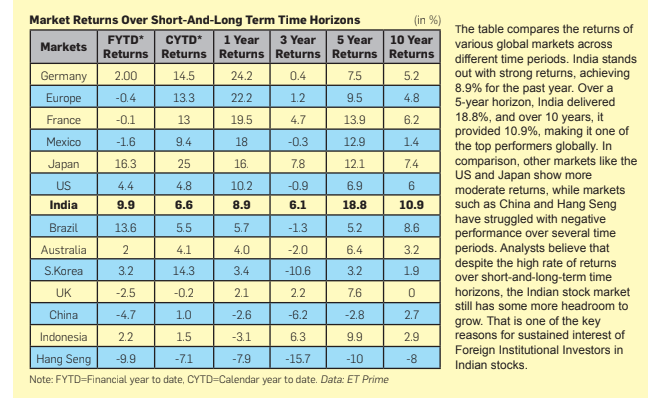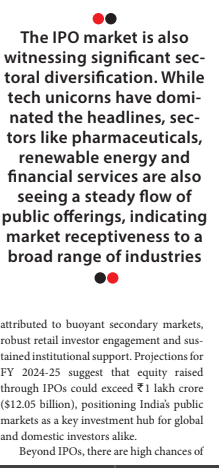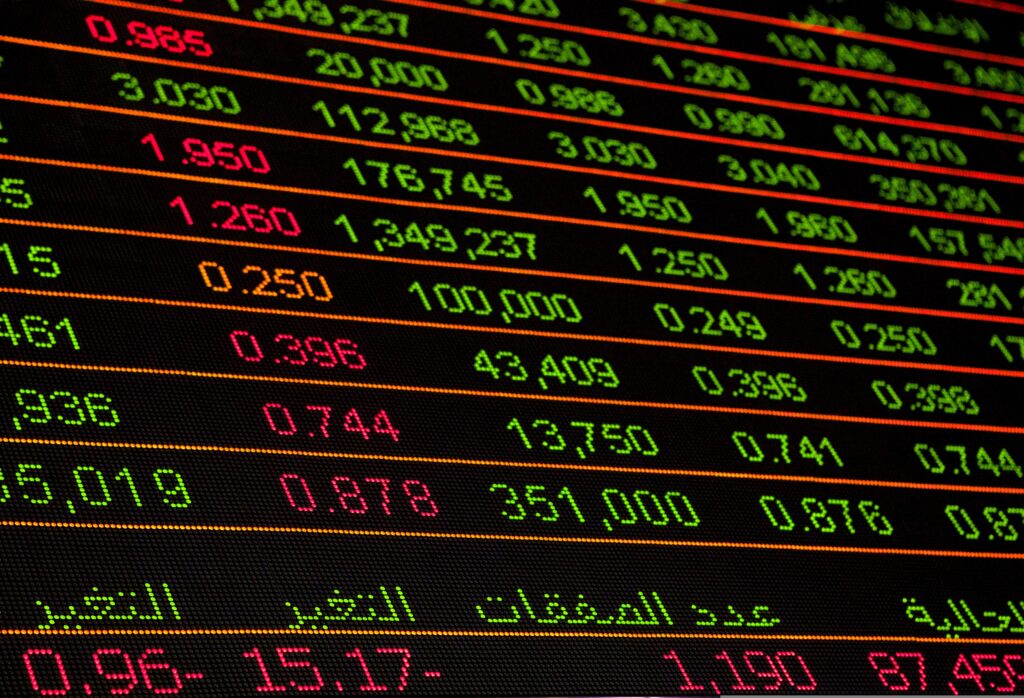With the Indian stock market continuing to defy global
trends, it has emerged as one of the hottest destinations
for investors, reflecting India’s growth story. As other
comparable markets show signs of slowing down, expect
the Sensex to touch new highs in the near future
The ongoing Russia-Ukraine
war, which is in its third year with no signs of ending in the near term, more than the Israel-Middle East conflict, might have had its reverberations across stock markets in Europe and the US but their Indian counterpart dealt with them as minor bumps and continued its northward journey. Geopolitical tensions, fear of a US or
European recession or apprehensions of high crude prices haven’t deterred the
Indian stock market. Not just in the short term but historically too Indian equities have outpaced
inflation by 6-8%, making them a strong
hedge against rising prices. Data highlights that maintaining a long-term investment horizon of five to seven years allows investors to weather market volatility and capitalise on the benefits of compounding,
ultimately delivering solid returns. The FundsIndia Wealth Conversations
report from August 2024 reveals a compelling insight: any investor who invested
in a basket of Nifty 50 stocks on any day since June 30, 1999, and held the investment for at least seven years, would have achieved returns exceeding 10% in 83% of cases. This demonstrates the resilience
and consistent performance of Indian equities over time. India’s Nifty 50 index
achieved annual returns of 12.56% compared to even top global fund Berkshire
Hathaway’s 9.52%. Indian stocks, in the long term, benefit from compounding, economic growth, and corporate profitability, making them a more attractive option for enduring wealth creation compared to more conservative or safe-haven assets. The compounded
annualised return of Nifty 50 over a 20-year time horizon is an impressive
14.8% as compared to other investment options (see Table 1). Among major economies in the postCovid period, the Indian stock market was among the fastest growing which gave the

highest returns, from a market capitalisation of less than rs 24.9 lakh crore ($300 billion) in 2003 to rs 107.9 lakh crore ($1.3 trillion) in 2014. It surpassed rs 473.1 lakh
crore ($5.7 trillion) in 2024, placing it among the top four stock markets globally
by market capitalisation. Further, it is poised to reach rs830 lakh crore ($10 trillion) by 2030.
Post-Covid Rebound
S ince the pandemic low in March 2020, the NSE Nifty 50 has surged over 200%, bringing India’s stock market capitalisation to around rs 47.31 lakh crore ($5.7 trillion.) This growth
reflects increasing investor confidence in India’s long-term economic potential, creating a virtuous cycle of liquidity, sell-side coverage, and capital issuance. Strong
returns have been largely driven by domestic institutional investors and a significant rise in retail participation. The money flowing into Indian equities is reaching unprecedented levels. There is already a steady monthly flow of
mutual fund money flowing into Indian equities. Domestic institutional investors, like the Life Insurance Corporation (LIC),
The FundsIndia Wealth
Conversations report from
August 2024 reveals a compelling insight: any
investor who invested
in a basket of Nifty 50 stocks on any day since June 30, 1999, and held the investment for at least
seven years, would have
achieved returns exceeding 10% in 83% of cases
have remained committed, with LIC alone investing over rs 1,30,000 crore annually. With global interest rates expected to fall, a flood of foreign money through Foreign Institutional Investors (FIIs) is anticipated to flow into Indian equities, adding fuel to the market’s ongoing rally. Another major reason is entry of Indian bonds in the global market through fully accessible route (FAR Bonds).
Bond Market: A Global Opportunity
India already has a 1% weight in the JP Morgan Emerging Markets (EM) Bond Index, set to gradually increase to 10% by March 31, 2025. This inclusion is projected to attract rs 1.6-rs 1.82 lakh crore ($20-22 billion) in inflows into India’s bond market, significantly boosting foreign participation. Currently, foreign holdings of India’s debt stand at 2.4% of the total outstanding debt, but JP Morgan expects this figure to nearly double by the end of 2025.
India’s rs 58.1 lakh crore ($700 billion) currency reserves, the fourth largest in the world, indirectly benefit the rupee by providing a strong buffer for the central bank to manage volatility, making the rupee one of the most stable currencies among emerging
markets. This provides the opportunity to expand the global debt inflows through
bonds. Following JP Morgan, Bloomberg,
and FTSE Russell are also including Indian bonds in Emerging Markets Government Bond Index (EMGB) from September 2025. Additionally, Indian bonds will feature in the
FTSE Asian Government Bond Index (AGBI) and the FTSE Asia-Pacific Government Bond Index (APGBI), further enhancing India’s global bond market presence.

A Hotbed Of Opportunities
India’s IPO market is witnessing heightened activity, driven by innovative
offerings and robust economic growth. This optimism is fuelled by increased domestic capital flows, liquidity influx,
stronger governance, a dynamic entrepreneurial ecosystem and supportive government policies, amplified by FDI. The rise in
financial literacy, coupled with strong institutional investor commitment, continues to sustain this momentum. The IPO market is also witnessing significant sectoral diversification. While tech
unicorns have dominated the headlines, sectors like pharmaceuticals, renewable
energy and financial services are also seeing a steady flow of public offerings. The market’s receptiveness to a broad range of industries has helped sustain the rally
in equities. In FY 2023-24, 76 companies raised
nearly rs 62,000 crore ($7.47 billion) through mainboard IPOs, marking a 19% increase over the previous year. The average first-day returns stood at 28%, with over 70% of the listed stocks still trading
above their issue price. These gains can be

more FPOs being issued in the future. Promoter ownership in India stands at a high 50%, compared to the 20-25% average in larger global markets, resulting in a lower free float for Indian stocks. According to the latest data, 16-18% of the Indian market is owned by Foreign Institutional
Investors (FIIs) and around 20% by Domestic Institutional Investors (DIIs), leaving the actual public float at just 12-15%. To maintain market attractiveness and balance, there is a growing need for
regular fresh equity issuances. This will not
only raise money from domestic investors but also improve corporate governance of Indian MNCs to attract foreign investments and develop new tech and business
partnerships.
Bubbles Or Fundamentals
There is valid scepticism that the market boom is fuelled by liquidity rather than pure fundamental growth. The market capitalisation to GDP ratio, which has surpassed 150%, supports this theory. However, despite the concerns of overvaluation of stocks or the Indian market
being ‘gone too far too fast’, the medium- to
long-term trajectory is highly positive as per expert market watchers and analysts. Further, the sentiments are that the corrections in the headline indices will mostly be time based and not price based. That means a few weeks or months may see stagnation
and small falls, but the prices will not reduce drastically. This may act as a buildup for a new mega bullish run.
A Catalyst For Growth
The Indian government has set ambitious plans to achieve $1 trillion (rs 83 lakh crore) in annual goods exports by 2030, positioning India as a key alternative for companies seeking to diversify away from China. In FY 2024, overall exports reached $778.2 billion (rs64.6 lakh crore), driven by India’s labour cost advantages compared to rising costs in China and the post-Covid surge in
exports, now the largest contributor to India’s GDP. The China+1 strategy is gaining traction globally, enhancing India’s role in global supply chains. While manufacturing capital expenditure has focused on import substitution, reducing imports as a percentage of GDP, the government aims to translate this growth into a larger share of global exports. Major initiatives like the National Infrastructure Pipeline (NIP) and Production-Linked Incentives (PLI)
schemes, with rs 116.2 lakh crore ($1.4 trillion) in infrastructure spending planned over the next five years, have driven significant expansion in sectors like railways, Metro projects and aviation. India has operationalised 75 new airports in the past decade and declared 111 new national waterways. India is also focused on its clean
energy transition, aiming to reduce import dependency and achieve net zero emissions by 2070. With a current renewable energy capacity of 197.20 GW, the government targets 500 GW by 2030, requiring an
According to Morgan Stanley, sectors
such as auto and auto ancillary, cement, defence, railways, consumer durables, energy, logistics, FMCG, capital goods,
engineering, infrastructure, construction, and banking and financials are poised to
be key outperformers in the upcoming market rally.
Veteran investor Mark Mobius says that leveraging cutting-edge technology,
government initiatives, large-scale investments and foreign interest in areas like
battery energy storage, green hydrogen, biotechnology, AVGC (Animation, Visual
Effects, Gaming, Comics) and semiconductor chip manufacturing, assembly and design are expected to generate significant returns through 2030-2035. Not just digital companies but industry, services, FMCG, hospitality, banking and finance According to Morgan Stanley, sectors such as auto and auto ancillary, cement, defence, railways, consumer durables, energy, logistics, FMCG, capital goods,
engineering, infrastructure, construction, and banking and financials are poised to be key outperformers in the upcoming market rally
estimated investment of rs 30 lakh crore ($360 billion).
Public Sector Undertakings (PSUs) have largely been overlooked over the past
15-17 years, with the past decade being particularly difficult for PSU stock investors. However, in the past 12 to 18 months,
PSUs have made a strong comeback, emerging as one of the best-performing
segments in the market. A stable rise in PSUs will prove a positive catalyst for the economy and the share market. According to Morgan Stanley, sectors
such as auto and auto ancillary, cement, defence, railways, consumer durables, energy, logistics, FMCG, capital goods,
engineering, infrastructure, construction, and banking and financials are poised to
be key outperformers in the upcoming market rally.
Veteran investor Mark Mobius says that leveraging cutting-edge technology,
government initiatives, large-scale investments and foreign interest in areas like
battery energy storage, green hydrogen, biotechnology, AVGC (Animation, Visual Effects, Gaming, Comics) and semiconductor chip manufacturing, assembly and design are expected to generate significant returns through 2030-2035. Not just digital companies but industry, services, FMCG, hospitality, banking and finance


companies too need to adapt to fast-changing technologies like AI and more. Only such companies or sectors can consider
constant growth in coming years. The Indian stock market’s rapid ascent is a testament to its resilience and strong fundamentals, even amid global economic
uncertainties. With impressive returns
driven by diverse sectors and robust liquidity inflows, India is solidifying its
place as a global investment hub. While concerns over market overvaluation exist,
the combination of government support,
favourable economic conditions and growing investor confidence suggests that the current momentum is sustainable in the medium to long term. As India continues to diversify its
economy, foster innovation and attract global capital, the stock market is poised
to offer substantial opportunities for wealth creation. For investors, maintaining a long-term perspective and focusing
on high-growth sectors such as energy, semiconductors and financial services will
be key to capitalising on India’s continued economic transformation.
Gold Prices Surge Amid Geopolitical Tensions and Seasonal Demand
Gold prices have been climbing recently, driven by rising geopolitical tensions, particularly the conflict between Israel and
Iran. The prices are in the range of rs75,000–rs80,000 for 10 gm of gold. Traditionally seen as a safe-haven asset, gold is gaining investor interest during
these uncertain times.
Dr Renisha Chainani, head of research at Augmont Gold For All, explains, “Geopolitical worries support the metal, although the strength of the US dollar and steady bond yields limit recent advances.” The potential for US Federal Reserve interest rate cuts, with futures traders pricing in a 75-basis point reduction by the end of 2024, further bolsters gold’s appeal.
Lower interest rates reduce the opportunity cost of holding gold, making it more attractive to investors. With the festive
season approaching in India, analysts anticipate increased gold purchases around Navratri and Dhanteras.
Additionally, the Indian government’s recent reduction in import duties on gold, announced in the Union Budget 2024, has
boosted general demand.
Gold’s uses are expanding beyond traditional investments and jewellery, with growing applications in electronics and renewable energy. Limited mining output combined with rising demand signals continued upward pressure on gold prices. For investors, gold remains a key hedge against
market volatility, offering both stability and long-term value.
Future Trends For Investment
According to JP Morgan and
Motilal Oswal, a combination of new-economy and traditional
sectors will fuel the growth of the Indian stock market.
Energy and Green Technology:
India is targeting 450 GW of
renewable energy capacity by 2030, with significant investment in battery storage and green hydrogen. The sector could require
more than rs 40 lakh crore ($500 billion) in investment, making it a
key growth area.
Semiconductors: With India’s semiconductor demand projected
to exceed rs 8.3 lakh crore ($100 billion) by 2025 and global market expectations reaching rs83 lakh crore ($1 trillion) by 2030, government incentives like the rs 83,000 crore ($10 billion) PLI scheme are driving significant
growth.
Defence and Railways: India’s
defence budget hit rs 5.94 lakh crore in 2023 and the defence manufacturing market is expected to grow to rs 2.16 lakh crore ($26
billion) by 2025. The railway sector also received rs 2.4 lakh crore for infrastructure modernisation.
Consumer Durables and FMCG:
Driven by rising incomes and urbanisation, India’s FMCG market is set to reach $220 billion by 2025, while consumer durables are
expected to grow at a 9.6% CAGR.
Auto and Auto Ancillary: The electric vehicle (EV) market in India is projected to grow at 49% annually, with sales expected to hit
1.7 crore (17 million) units by 2030. The auto component industry is set to become a rs 17 lakh crore ($200 billion) market by
2026.
Banking and Financial Services:
India’s fintech market is forecast to reach rs 107 lakh crore ($1.3 trillion) by 2025, with strong growth in
digital banking and financial
inclusion driven by government initiatives.


Add Comment